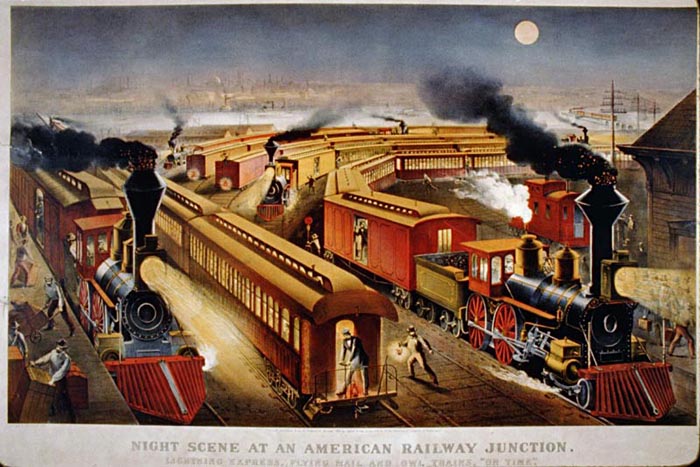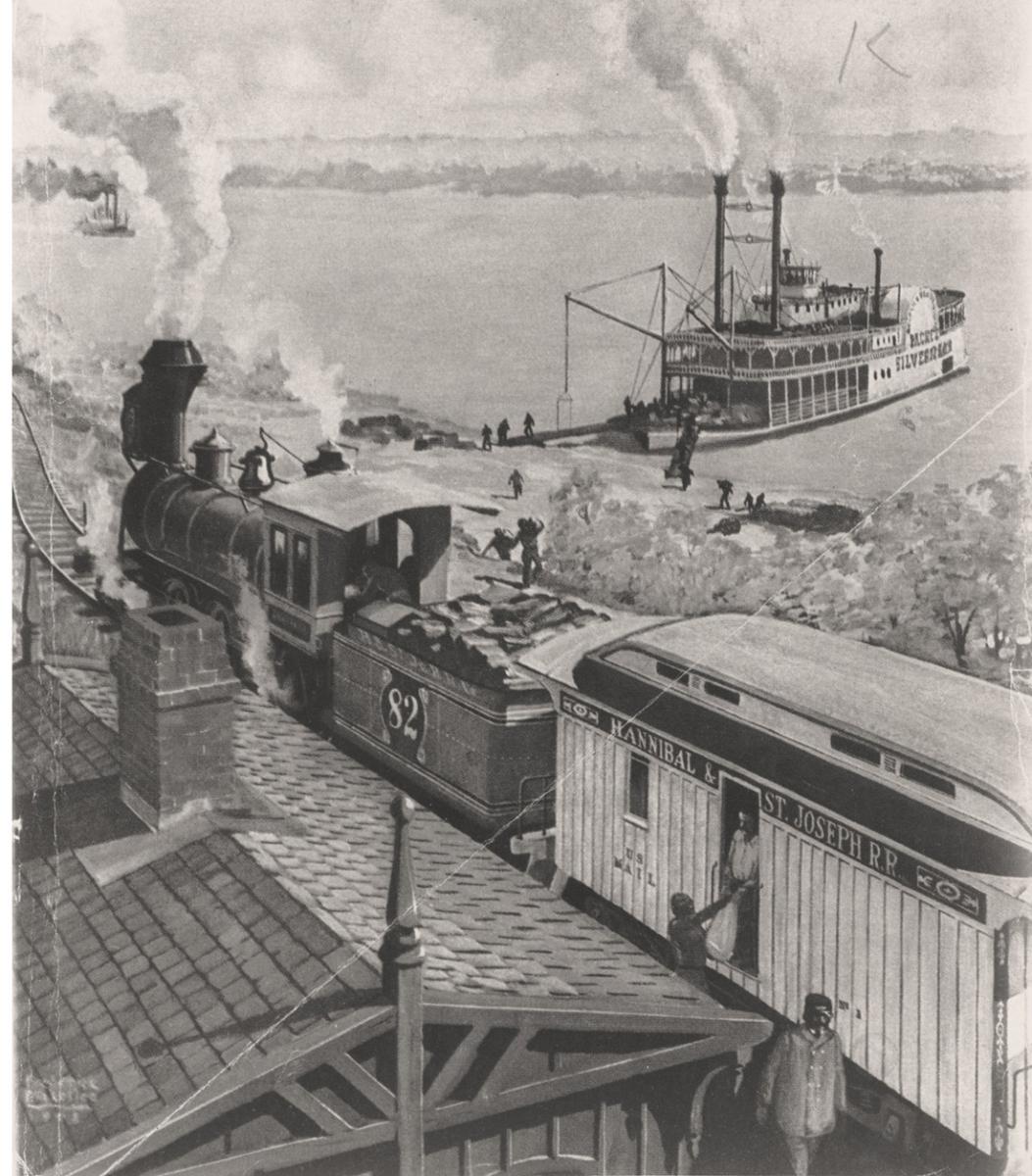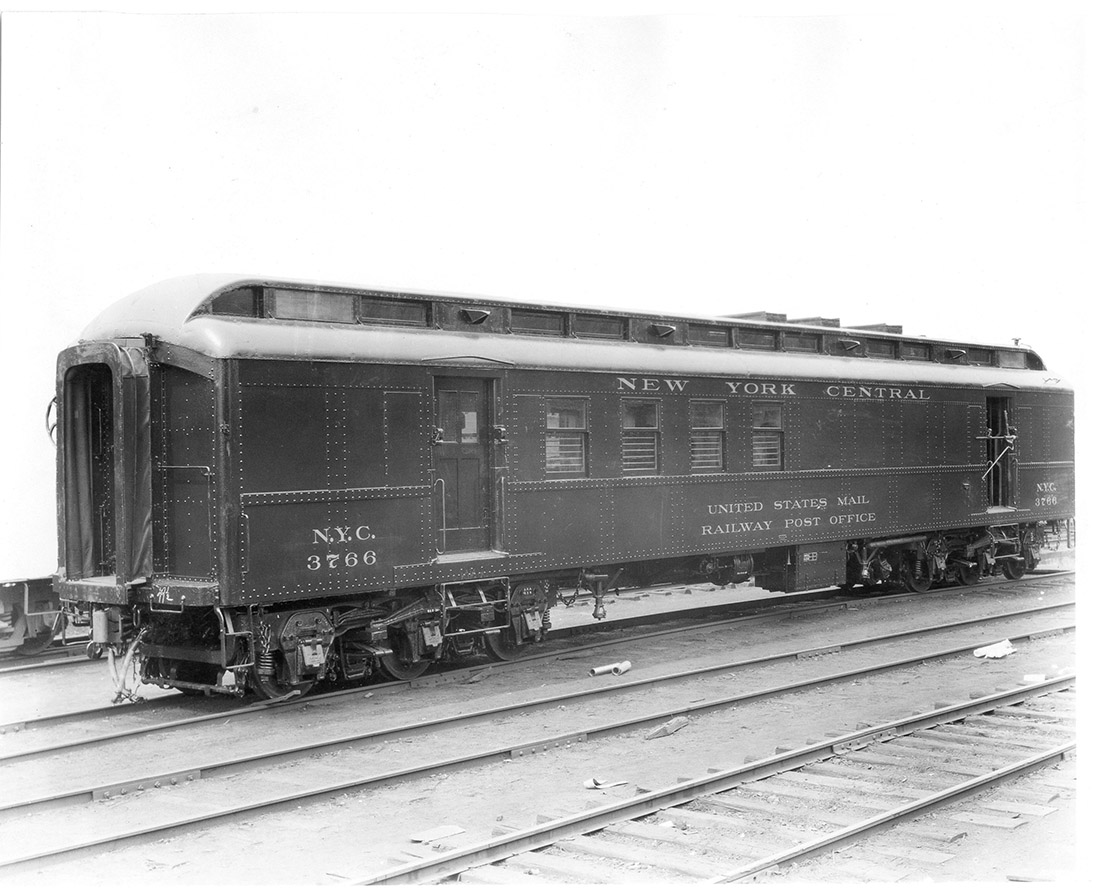
The Fast Mail
A History of the U.S. Railway Mail Service
Fall 2005, Vol. 37, No. 3
By Fred J. Romanski
The railroad station attendant at Mishawaka, Indiana, hurried to tie the morning mail pouch to a crane aside the tracks of the station, in anticipation of the morning passing of the "20th Century Limited," the premier train on the New York Central System, then quickly approaching the small station.
As the "Century" entered a gentle curve leading to the station, a clerk in the door of its railway post office car surveyed the passing landscape, looking for a large oak tree near the bend in the curve. The tree served as a point of reference for him to use as the spot from where he should toss the morning mail pouch for Mishawaka, allowing momentum and the train's speed to carry it to the station.
After tossing the pouch, the clerk quickly extended the train's railway post office catcher arm in time to hook "on the fly" the unprocessed mail pouch as the train sped on to Chicago.
For many who may have witnessed scenes like the morning dispatch and pickup of mail at Mishawaka, little thought was probably given to one of the more visible activities of the Railway Mail Postal Service. For more than 140 years between 1832 and 1977, it set the standards for speed, dependability, and response to the mission of moving and distributing the nation's mail.
From its humble beginnings during the nation's early years, the Railway Mail Postal Service became a leading force and player in connecting and facilitating the movement of mail and commerce. It served in this role until its end on June 30, 1977, when trucks and airplanes supplanted trains as the dominant mode of mail transport.
The Early Years, 1830–1876
In part as a response to criticism from businesses and the public that the mails, then moving by horse and stagecoach, were too slow, the postmaster general in the early 1830s decided to put the mails on trains. On December 5, 1832, Slaymaker and Tomlinson, stage route contractors of the time, also began carrying the mail by rail from Lancaster to West Chester, Pennsylvania, marking the official beginning of the use of rail by the U.S. Post Office department to transport the mail.
The early 1830s through 1876 was a time of multiple first steps, new legislation, and management problems for the burgeoning railway mail service. In 1837, railroad mileage in the country totaled 1,497 miles. The first recorded instance of a clerk being appointed to accompany the mail in transit on a railroad car and have charge of the mails occurred in May 1837 with the appointment of John E. Kendall as a route agent.
In 1838 and 1840, agents were assigned to attend the mail between Washington, D.C., and Philadelphia and between Boston and Springfield, Massachusetts. These early initiatives marked the beginnings of the railway mail service in the United States.
Records about the work performed by clerks on railroads in the early days are meager, but it is thought that there was a gradual development in the scope of the work up to 1864, when all mail in transit began to be distributed in railroad cars. Until then, mail was distributed to larger post offices, and the only mail sent to rail cars for handling was that which was intended for delivery at local points along the various lines. Route agents on the trains opened pouches received from local offices, took out mail for other local points on the line, and sent the balance of the mail into the terminal office for distribution. Most mail traveled in closed pouches or sacks, unopened from one terminal post office to the next, where it was held for examination, separation, and dispatch on the next day.
Significant early legislation that affected the mail service included an act of Congress approved July 7, 1838 (5 Stat. L. 283), that declared that all railroads in the United States were post roads. This designation was a reference back to the nation's earliest mail service established in 1775 by the Continental Congress, which emulated the British system of posts for carrying letters. The act had a twofold effect: it increased the use of railroads to transmit the mails and limited the use of post riders and horse-drawn vehicles to post offices that were not on railway routes. In those areas of the country that were not on railroad routes, mail was carried by contractors, and the transportation of mail between post offices by any means other than by boat or railroad was called star route service.
Seven years later on March 3, 1845, another act of Congress formally addressed the need to provide for service to small post offices and people who lived in towns away from railroad lines, a requirement that until then had been handled by contractors. The 1845 act formalized the star route system of contract service and required that the Postmaster General award the routes to the lowest bidder.
In the mid-19th century, the Post Office faced many problems, as its 1853 annual report enumerated. Foremost on that list was the problem of establishing a fixed rate of pay per mile for the railroads. When disagreements occurred between the Post Office and the railroads, the end result was often that the railroads refused the mail, and service was disrupted.
On other occasions, the railroads failed to adhere to schedules of set times of arrival and departure of the mails, leaving the Post Office feeling that the railroads were beyond their control. Insufficient numbers of mail cars, difficulty in finding suitable rooms to house distributing post offices in large cities, and defective methods of mail distribution wasted both time and money. An 1885 history of the Railway Mail Service noted that:
Letters, instead of having one or at most two distributions, have been distributed four or five times before their arrival at the destination point. The consequence has been that the distribution and delivery commissions have almost consumed the postage and contributed to delays.
The years from 1862 to 1864 were pivotal in the evolution of the railway mail service. On July 7, 1862, Postmaster General Montgomery Blair called for the establishment of the nation's first railway post office car on the Hannibal and St. Joseph Railroad between Hannibal and St. Joseph, Missouri.
The suggestion for such a car and service appears to have originated with William A. Davis, then assistant postmaster at St. Joseph. Overland mail from the east backed up in St. Joseph as a result of poor conditions of the railroad or missed connections with California-bound stagecoaches and the "Pony Express."
Davis's solution was to distribute and dispatch the overland mail in transit on specially prepared railroad cars. Though crude, the car contained an early letter case for sorting mail, small work tables, and oversize doors that allowed for easy access.
The Railway Post Office (RPO) idea advanced by Davis was by no means new. A "travelling post office," consisting of a 16-foot converted "horse box," was in service in England in 1838. The car was equipped with a "mail catcher," consisting of a net that could be swung out from the side of the car to retrieve pouches suspended along the track. France, too, had its RPO, called "Le Bureau Ambulant," long before the idea was contemplated in the United States. Though it originated on a small scale, the idea of distributing mail in transit on postal rail cars, thereby reducing the need for distributing post offices, slowly caught on.
Impetus for the idea of distributing the mails in transit gained valuable momentum under Third Assistant Postmaster General A. N. Zevely, who convened a meeting in Washington, D.C., in the summer of 1864. At that meeting, it was determined that the Post Office Department would try the experiment of railway postal service, and two special agents, George B. Armstrong and Harrison Park, were designated to test its practicality.
The department divided the states and territories into western and eastern divisions. Armstrong controlled the western division, comprising all the states and territories west of the east line of Indiana and south of the Ohio River, and Harrison Park directed the eastern division. The first railway postal route in operation was on the Iowa division of the Chicago and Northwestern Railroad, from Chicago to Clinton, Iowa, on August 28, 1864. In the east, railway postal cars were placed on the Pennsylvania Central and Erie railroads, all in 1864. In 1865 and 1866 additional roads received railway postal routes as the Post Office Department became satisfied that the system was not only practicable but was meeting the needs of the people and the department.
From 1867 onward, the Post Office Department introduced railway postal service on main trunk lines and more important roads whenever it could be done without demanding too large an amount for the extra accommodations. On average, two clerks were assigned to the cars, although on some routes it was necessary to have more because of the large amount of mails to be distributed, such as on the morning run between Portland, Maine, and Boston, when three men were required on both the day and night runs.
Early clerks' knowledge of mail distribution, geography, and processing of mail was rudimentary, and facilities afforded for studying were limited. Clerks usually met informally in small groups at junction points along the line to study maps and share information about what mail could best be handled by their lines. In 1868, during the tenure of Armstrong and Park, the first recorded schemes, showing maps of a state which helped clerks understand the distribution of the mails, were implemented along with checks to detect errors in processed mail.
Under the guidance of General Superintendent George S. Bangs from 1871 to 1876, the Railway Mail Service instituted separation of the mails by states, an innovation that further served to reduce backups of mail by dispatching the mail for each state to the most distant railway post office that could process it. The number of clerks in the railway postal service, including route agents, mail route messengers, and local agents, reached 2,286, and the number of miles of railroad upon which mail was carried totaled 70,083.
The Ward mail-bag catcher, first used in 1869, grew in acceptance and use by clerks. Before 1869, a mail clerk used only his arm to catch mail while the train was in motion. The Ward device, which used a steel catcher arm affixed to the door of railway post office cars, allowed clerks to extend the catcher arm at selected points on the route and pick up mail from a fixed crane on the fly. Bangs was also a proponent of the "fast mails," and in his 1874 annual report, he identified the need for a fast and exclusive mail train between New York and Chicago "designed to expedite the movement of mail from the east to the west and cover the distance in about twenty-four hours."
With help from participating railroads, namely the New York Central and the Pennsylvania railroads, the first five-car train was assembled on September 16, 1875. The train traveled from New York City to Albany, Buffalo, Cleveland, Toledo, and Chicago on its first trip and carried more than 33 tons of mail.
From September 16, 1875, to July 22, 1876, the fast mail never missed a single connection and failed to arrive in Chicago on time only on three occasions. On trips east, the train failed to arrive in New York on time only once. The effect of the fast mails on the overall mail distribution system was to reduce the time in transit and promote efficiency of service, because the fast mail made connections at all important junctions serviced by the regular trains from throughout the country. Though an operational success, the fast mail lasted in its original form only from September 1875 to July 1876, when Congress instituted a 10-percent reduction in service.
Though cut back, fast mail service led to the establishment of additional railway post office lines between New York, St. Louis, and Cincinnati via the Pennsylvania Railroad and its connections with Philadelphia, Pittsburgh, Columbus, and Indianapolis.
The Middle Years, 1876–1911
Labor Relations and the Railway Mail Service
Between February 4, 1876, and March 19, 1889, the Railway Mail Service expanded from 8 to 11 divisions. On August 1, 1882, Order No. 354 of the postmaster general reorganized the railway mail service, set classifications, and fixed salaries for its employees. Route agents, mail messengers, and local agents were no longer part of the service; employees were known as railway postal clerks, and all rail lines covered by the service were referred to as railway post offices.
On May 1, 1889, the Railway Postal Service became part of the classified civil service, and by 1896 all promotions were based on rules prescribed by the Civil Service Commission. Under civil service rules, after passing a competitive entrance exam for the service, advancement and promotion were based on merit, determined through an ongoing process. For railway mail clerks, the heart of the merit promotion process that determined a clerk's standing in the civil service system was the card case examination.
Card case examinations tested clerks on the locations of urban and rural post offices in states, connecting and intersecting railway post offices, mail distribution routes, and postal regulations. The examinations were generally administered at the office of the division superintendent, using a letter case consisting of pigeonholes and boxes labeled with the names of various railway and local post offices.
During an examination, the clerk received three-by-five-inch cards bearing the written address of each post office in a state, and he was required to correctly distribute the cards from memory. The clerk was questioned as to his knowledge of connections and his printed book of instructions. The examiner noted the time consumed in distributing cards, and these times became a part of the clerk's record. The clerk then received a statement of the results of the examination as well as information on the subject of his next examination.
All reexaminations were made at such times as the division superintendent might designate. Examinations were frequent enough to provide a continuous record of a clerk's efficiency, and railway postal clerks were expected to score between 97 and 99 percent on their exams. The proper dispatch of the mails via multiple railway postal routes required considerable study. Each line served a specific territory, and a clerk assigned to any line was required to learn the territory served by the line and maintain examination grades on several states, passing review examinations at least once every three years.
The postmaster general's 1896 annual report for the Railway Mail Service indicates that the mails were carried on 172,794 miles of railroad, and 6,779 postal clerks were employed on 152,825 miles of traveling post offices that included railroads, steamboats, and electric cars. The report also chronicled improvements in railway post office car construction that included cars with vestibules (enclosed passages between passenger cars of a train), larger and safer interior lighting, and better couplers and buffers between railroad cars. All of these improvements enhanced clerks' chances for survival in derailments and railroad wrecks.
The issue of safety on the job and working conditions loomed particularly large for railway mail clerks as the 1890s drew to a close. Casualty figures for the years 1877 to 1896 showed that 94 clerks were killed in the line of duty, and 821 were seriously injured on the job through derailments, falls, drownings, fires, and other work-related accidents.
Among those other work-related accidents were train robberies, which, although infrequent, plagued the railway mail service from the 1860s through the 1920s, when men such as Jesse and Frank James and later the Newton and De Autremont brothers made being a railway mail clerk dangerous at times. The potential for violence and the threat from robberies led to the arming of railway postal clerks.
For the Railway Mail Service, the opening years of the 20th century were marked by continuing safety problems associated with the use of wooden railway postal cars, unsanitary working conditions in many of those cars, and the requirement on many occasions for clerks to work overtime beyond an eight-hour day without compensation. Such instances, coupled with the failure on the part of Post Office Department management to address employee grievances in a rapid manner, forced employees through their service-craft organizations to take a more militant stance.
Through the National Association of Railway Postal Clerks, postal employees appealed to the public and to Congress. An officer of the organization was subsequently removed from the service because such activity was banned under a "gag rule" issued by President Theodore Roosevelt in 1902. Roosevelt's series of gag orders prohibited employees of the United States, individually or through organizations, "to solicit an increase in pay or to influence or attempt to influence in their own interest, any other legislation whatever, either before Congress or its committees, or in anyway save through the heads of the Department." In 1909 President William Howard Taft issued an order forbidding employees to respond to any request for information by Congress, except through the department head. These orders crippled the postal unions but gained for them sympathy and friends among the members of Congress. After an extended investigation, the Lloyd-LaFollette Act of 1912 rescinded the gag rule and gave employees more security in employment and freedom to engage in union activity.
A Typical Day as Train No. 8 Speeds Eastward
Fred J. Romanski is an archivist with the Civilian Records Branch, Textual Archives Services Division at the National Archives and Records Administration, College Park, MD. He specializes in law enforcement records of the Department of Justice and has an interest in U.S. railroad history. The writer's father is a retired railway mail clerk.


